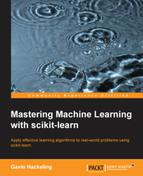Book Description
Apply effective learning algorithms to real-world problems using scikit-learn
In Detail
This book examines machine learning models including logistic regression, decision trees, and support vector machines, and applies them to common problems such as categorizing documents and classifying images. It begins with the fundamentals of machine learning, introducing you to the supervised-unsupervised spectrum, the uses of training and test data, and evaluating models. You will learn how to use generalized linear models in regression problems, as well as solve problems with text and categorical features.
You will be acquainted with the use of logistic regression, regularization, and the various loss functions that are used by generalized linear models. The book will also walk you through an example project that prompts you to label the most uncertain training examples. You will also use an unsupervised Hidden Markov Model to predict stock prices.
By the end of the book, you will be an expert in scikit-learn and will be well versed in machine learning
What You Will Learn
- Review fundamental concepts including supervised and unsupervised experiences, common tasks, and performance metrics
- Predict the values of continuous variables using linear regression
- Create representations of documents and images that can be used in machine learning models
- Categorize documents and text messages using logistic regression and support vector machines
- Classify images by their subjects
- Discover hidden structures in data using clustering and visualize complex data using decomposition
- Evaluate the performance of machine learning systems in common tasks
- Diagnose and redress problems with models due to bias and variance
Downloading the example code for this book. You can download the example code files for all Packt books you have purchased from your account at http://www.PacktPub.com. If you purchased this book elsewhere, you can visit http://www.PacktPub.com/support and register to have the files e-mailed directly to you.
Table of Contents
- Mastering Machine Learning with scikit-learn
- Table of Contents
- Mastering Machine Learning with scikit-learn
- Credits
- About the Author
- About the Reviewers
- www.PacktPub.com
- Preface
- 1. The Fundamentals of Machine Learning
- 2. Linear Regression
- 3. Feature Extraction and Preprocessing
- 4. From Linear Regression to Logistic Regression
- 5. Nonlinear Classification and Regression with Decision Trees
- 6. Clustering with K-Means
- 7. Dimensionality Reduction with PCA
- 8. The Perceptron
- 9. From the Perceptron to Support Vector Machines
- 10. From the Perceptron to Artificial Neural Networks
- Index
